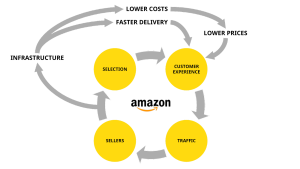This ecommerce strategy article is an excerpt from our new book, The Ultimate Ecommerce Email & SMS Playbook. We’re diving into our ecommerce strategy chapter focused on the 7 Reasons Why Ecommerce Customers Leave Your Brand.

Reason 4. The Flywheel’s Dominance
Most brands understand the concept of a funnel. You drive qualified traffic to a landing page or lead magnet, capture the visitor data and nurture that lead into a customer.
For e-commerce brands, though, the funnel is about as useful as a sieve. Acquiring a one-time customer is relatively easy compared to keeping a customer loyal and gaining multiple purchases. In fact, 74% of e-commerce customers remain one-time buyers, so the funnel only serves to attract low-profit, discount-hunting customers.
The flywheel is the better approach for creating profitable, predictable, and sustainable e-commerce growth. In the book, Good to Great, by Jim Collins, the flywheel acts as a constant source of acquiring, converting, and retaining customers, all on the power of its own momentum. And that flywheel concept – which I highly recommend you study up on! – is reason number four for why customers leave you: Amazon’s flywheel.
Currently, Amazon sets the pace on logistics and selection for customers. And we’ve already established that Amazon is the leader in scale and search. But what does it look like when you piece all those advantages together? Take a good look at the Amazon flywheel.
Take the flow step-by-step. Amazon focused everything on customer experience and superior software. Jeff Bezos reasoned that if the customer experience, product selection, and ease of checkout were simple, intuitive, and personalized, customers would come back. That’s the second stage: traffic. The better the experience, the more traffic to the website.
With more traffic to the website, Amazon became more popular, which was attractive to book publishers at the time who saw an opportunity to sell more books, accessories, and magazines. The number of sellers grew, which led to higher selection.
And not just a large selection but also, due to the power of Amazon’s technology, a curated selection of products personalized to the customer. Personalization leads to a better customer experience, which leads to more traffic. More traffic leads to even more sellers, new product categories, and new revenue streams, which is the definition of more selection. Amazon created the perfect e-commerce flywheel that’s running on its own momentum.
Incidentally, their flywheel was so good that Amazon was able to create a separate business unit focused on selling their own technology to other brands looking to scale their business.
That business unit is now known as Amazon Web Services. AWS owns 33% of the cloud computing market, and it’s on track to hit $71 billion in annual revenue on 40% annual growth.
According to McKinsey, 75% of e-commerce brands made two-day delivery a priority in 2021, and 42% made same-day delivery a priority this year in 2022. Amazon launched free two-day delivery with Prime membership back in 2005, 15 years ahead of everyone else! Let that number sink in – 3 out of 4 brands are trying to make two-day delivery a priority, not even a guarantee. True to form, while brands are struggling to play catch-up, Amazon already launched one-day delivery in 2019.

Amazon is simply more convenient than you, and the ultimate form of customer loyalty within e-commerce is convenience. Amazon will deliver to you in two days, then one day, then two hours for Prime Grocery, then one hour in certain areas, and, shortly, brick and mortar in-store pickup. The barrier to competing with Amazon’s dominant flywheel is too high.
Let’s recap where Amazon is. They have the scale and selection, they get first-pass by being the default search engine for shoppers, they can fulfill faster, cheaper, and more efficiently than anyone, and they value-stack every order with great add-ons. That entire flywheel is why your customers leave for Amazon.
So, for brands that aren’t named Amazon, what’s the alternative? Throw our hands up in the air and give in? No, you have plenty of options, and here’s one of the more popular ones: pair with a technology that can meet your customer where they are. If customers expect an “Amazon-like” experience everywhere they shop, you’ll need to partner with the right apps, tech, and vendors to meet that customer where they are.
Meeting a customer where they are allows e-commerce brands to deliver on customer expectations on selection, fulfillment, service, and experience. For most brands, that means getting a better technology partner. For example, if a restaurant doesn’t have a mobile-friendly, easy-to-navigate website, online menu, or easy ordering experience, they can partner with DoorDash, UberEats, or Seamless to create the experience customers demand.
Those apps and technologies will certainly help level the playing fields to a degree, but, as you’ll learn next, that partnership comes with a major challenge to your customers and bottom line.
Loved the article? Take one of these next steps:
